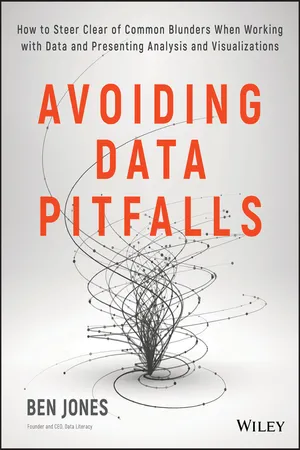
Avoiding Data Pitfalls
How to Steer Clear of Common Blunders When Working with Data and Presenting Analysis and Visualizations
- English
- ePUB (mobile friendly)
- Available on iOS & Android
Avoiding Data Pitfalls
How to Steer Clear of Common Blunders When Working with Data and Presenting Analysis and Visualizations
About this book
Avoid data blunders and create truly useful visualizations
Avoiding Data Pitfalls is a reputation-saving handbook for those who work with data, designed to help you avoid the all-too-common blunders that occur in data analysis, visualization, and presentation. Plenty of data tools exist, along with plenty of books that tell you how to use them—but unless you truly understand how to work with data, each of these tools can ultimately mislead and cause costly mistakes. This book walks you step by step through the full data visualization process, from calculation and analysis through accurate, useful presentation. Common blunders are explored in depth to show you how they arise, how they have become so common, and how you can avoid them from the outset. Then and only then can you take advantage of the wealth of tools that are out there—in the hands of someone who knows what they're doing, the right tools can cut down on the time, labor, and myriad decisions that go into each and every data presentation.
Workers in almost every industry are now commonly expected to effectively analyze and present data, even with little or no formal training. There are many pitfalls—some might say chasms —in the process, and no one wants to be the source of a data error that costs money or even lives. This book provides a full walk-through of the process to help you ensure a truly useful result.
- Delve into the "data-reality gap" that grows with our dependence on data
- Learn how the right tools can streamline the visualization process
- Avoid common mistakes in data analysis, visualization, and presentation
- Create and present clear, accurate, effective data visualizations
To err is human, but in today's data-driven world, the stakes can be high and the mistakes costly. Don't rely on "catching" mistakes, avoid them from the outset with the expert instruction in Avoiding Data Pitfalls.
Frequently asked questions
- Essential is ideal for learners and professionals who enjoy exploring a wide range of subjects. Access the Essential Library with 800,000+ trusted titles and best-sellers across business, personal growth, and the humanities. Includes unlimited reading time and Standard Read Aloud voice.
- Complete: Perfect for advanced learners and researchers needing full, unrestricted access. Unlock 1.4M+ books across hundreds of subjects, including academic and specialized titles. The Complete Plan also includes advanced features like Premium Read Aloud and Research Assistant.
Please note we cannot support devices running on iOS 13 and Android 7 or earlier. Learn more about using the app.
Information
Chapter One
The Seven Types of Data Pitfalls
Seven Types of Data Pitfalls
Pitfall 1: Epistemic Errors: How We Think About Data
- Assuming that the data we are using is a perfect reflection of reality
- Forming conclusions about the future based on historical data only
- Seeking to use data to verify a previously held belief rather than to test it to see whether it's actually false
Pitfall 2: Technical Traps: How We Process Data
- Dirty data with mismatching category levels and data entry typos
- Units of measurement or date fields that aren't consistent or compatible
- Bringing together disparate data sets and getting nulls or duplicated rows that skew analysis
Pitfall 3: Mathematical Miscues: How We Calculate Data
- Summing at various levels of aggregation
- Calculating rates or ratios
- Working with proportions and percentages
- Dealing with different units
Pitfall 4: Statistical Slipups: How We Compare Data
- Are the measures of central tendency or variation that we're using leading us astray?
- Are the samples we're working with representative of the population we wish to study?
- Are the means of comparison we're using valid and statistically sound?
Table of contents
- Cover
- Table of Contents
- Preface
- Chapter One: The Seven Types of Data Pitfalls
- Chapter Two: Pitfall 1: Epistemic Errors
- Chapter Three: Pitfall 2: Technical Trespasses
- Chapter Four: Pitfall 3: Mathematical Miscues
- Chapter Five: Pitfall 4: Statistical Slipups
- Chapter Six: Pitfall 5: Analytical Aberrations
- Chapter Seven: Pitfall 6: Graphical Gaffes
- Chapter Eight: Pitfall 7: Design Dangers
- Chapter Nine: Conclusion
- Index
- End User License Agreement